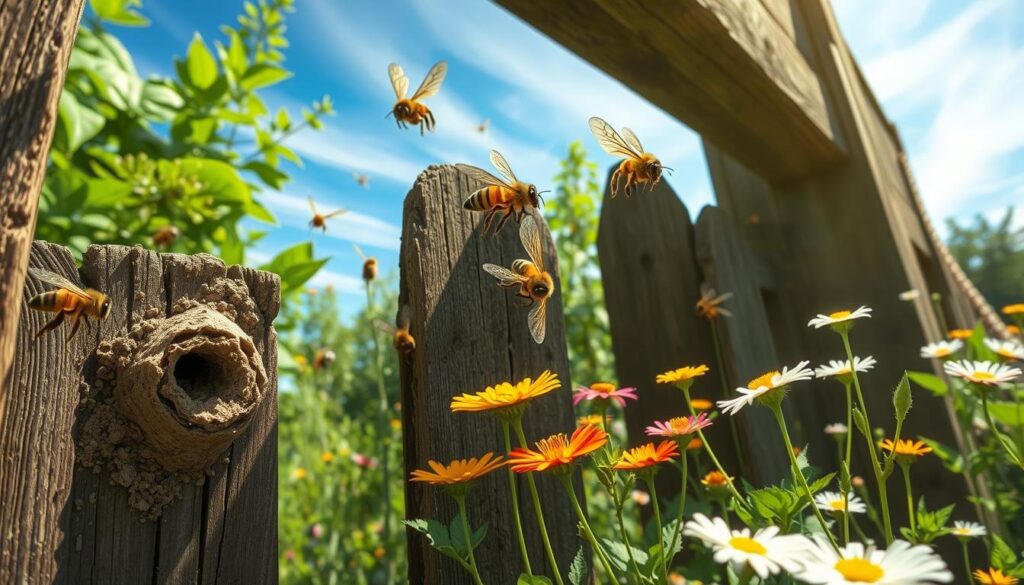Did you know that not all bees in your backyard make honey or live in hives? New Jersey’s buzzing ecosystem hosts a surprising variety of bees, each playing a unique role in keeping local gardens and farms thriving. This guide unlocks the secrets behind the types of bees in nj, making identification simple with 2025 photos and expert insights.
From the familiar honey bee to the lesser-known leafcutter, each species has traits that set it apart. Discover how their behaviors, nesting habits, and pollination roles shape New Jersey’s environment. Whether you’re a gardener, nature enthusiast, or curious observer, this guide answers questions like: Which bee is harming my deck? Which one helps my tomato plants grow? Every detail is backed by real-world examples and visuals to match what you see outdoors.
Key Takeaways
- Learn to spot 5 distinct bee types in New Jersey using photo examples.
- Understand how each species supports local agriculture and biodiversity.
- Discover differences between social bees like bumblebees and solitary ones like mason bees.
- Find out why some bees are essential for garden health—without harming your home.
- Get tips to protect these pollinators through simple backyard practices.
Overview of Bees in New Jersey
New Jersey’s diverse landscapes host over 400 native bee species in New Jersey, each playing unique roles in sustaining local ecosystems. These insects are essential for pollinating wildflowers, fruit trees, and agricultural crops like blueberries and apples.
Importance of Bees in Ecosystems
“Without bees, New Jersey’s forests and farms would lose up to 70% of their plant diversity,” warns a 2023 Rutgers University study.
Bees pollinate 75% of the state’s flowering plants, aiding food production and habitat restoration. Their activity supports endangered plant species in parks like the Pinelands National Reserve.
Overview of Bee Populations in NJ
Recent surveys reveal:
- Over 40% of NJ’s native bee species in New Jersey are at risk due to habitat loss
- Bumblebees and carpenter bees dominate urban areas, while mason bees thrive in rural regions
- State conservation programs track 15 priority species, including the rusty patched bumblebee
Understanding these bee species in New Jersey helps communities protect pollinators critical to both nature and agriculture.
Honey Bees: The Most Familiar
Honey bees in New Jersey are the stars of the pollination world. These social insects thrive in organized colonies, making them a cornerstone of local ecosystems. Their recognizable buzz and golden honey have made them a symbol of nature’s teamwork.
Physical Characteristics
Adult honey bees measure about ½ inch long with fuzzy, striped bodies. Apis mellifera, the European honey bee, is the most common species here. Their bodies feature three key parts: head, thorax, and abdomen. Notable traits include:
- Transparent wings for rapid flight
- Barbed stingers (workers only)
- Antennae for sensing flowers
Role in Pollination
Honey bees in new jersey pollinate over 50% of the state’s fruit crops. Their foraging habits directly benefit farms growing:
- Blueberries
- Peaches
- Pumpkins
- Wild blackberries
“Without honey bees, New Jersey’s $35 million blueberry industry would collapse,” stated a Rutgers University study.
Honey Production Process
Producing honey involves three steps: collecting nectar, processing it into honey, and storing it in wax combs. Worker bees:
- Collect nectar from flowers
- Use enzymes to break down sugars
- Fan wings to evaporate water content
Local apiaries in New Jersey harvest this liquid gold without harming colonies, ensuring sustainable practices.
Bumblebees: The Big, Fuzzy Buzzing Bees
Bumblebees are a familiar sight in NJ’s gardens and meadows. Their fuzzy, buzzing presence makes them easy to spot. These vital pollinators play a big role in local ecosystems. Understanding their habits helps residents support their survival in New Jersey.
Identification Features
- Furry bodies with black and yellow stripes stand out in gardens.
- Larger than honeybees but smaller than carpenter bees, they’re often seen bumbling between flowers.
- Wings fold neatly when resting, unlike other bees that hold wings flat.
Nesting Habits
Bumble bees NJ choose unique nesting spots. They often take over abandoned rodent holes or nest in tall grass. Queens start colonies alone in spring, laying eggs in cozy underground chambers. Colonies stay small compared to honeybee hives.
Living in Colonies
Colonies have a queen, workers, and males. Worker bees gather nectar and pollen to feed larvae. By winter, only new queens survive, starting new nests in spring. This cycle keeps NJ’s ecosystems thriving.
Carpenter Bees: The Woodworkers
Carpenter bees new jersey residents often spot are unique due to their solitary nature and preference for wooden surfaces. These insects, common in backyard landscapes, differ from honey bees with their sleek, hairless abdomens. Males lack stingers, while females drill precise tunnels in untreated wood.
Distinguishing Features
- Appearance: Black or metallic blue bodies up to 1 inch long.
- Flight patterns: Males hover near nesting sites, while females burrow silently.
Behavior and Nesting
Unlike social bees, carpenter bees new jersey homeowners encounter nest alone. They carve tunnels into decks, eaves, or fences, preferring unpainted softwoods like cedar. Each female constructs a private chamber for eggs, leaving visible holes with sawdust piles below.
Impact on Wood Structures
Repeated nesting weakens wooden structures over time. Yearly tunneling can lead to rot or entry points for moisture. Homeowners in New Jersey report damage on porches and outdoor furniture. Early detection minimizes repair costs and prevents long-term decay.
Mason Bees: The Solitary Pollinators
Mason bees are a standout example of solitary bees in nj, thriving without hives or colonies. These gentle insects play a big role in local gardens, using unique methods to nest and pollinate plants. Unlike social bees, each mason bee works alone but together boosts ecosystem health.

Unique Physical Traits
With sleek metallic blue or black bodies, mason bees look different from fuzzy honey bees. Their hairless abdomen contrasts with bumblebees, and their size—smaller than carpenter bees—makes them easy to spot in NJ backyards. Their legs carry pollen directly to plants, boosting efficiency.
Nesting Preferences
Solitary bees in nj prefer natural gaps like hollow twigs or abandoned beetle holes. They also use human-made bee hotels. Here’s how they nest:
- Fill nest tunnels with mud or clay to seal eggs
- Choose sunny, sheltered spots like fence posts or garden structures
- Each female builds her own nest, no shared hive needed
Role in Pollination
Mason bees pollinate 100x more flowers per bee than honey bees. Their messy pollen collecting—rubbing against blooms instead of collecting pollen directly—makes them top pollinators for NJ apple orchards and blueberry fields. Since they fly in cool weather, they’re active when other bees stay indoors.
Protecting these solitary bees in nj means leaving some bare soil for mud sources and avoiding pesticides. Their work ensures better harvests without the buzz of a hive.
Leafcutter Bees: The Garden Helpers
Leafcutter bees are unsung heroes in New Jersey gardens. These native bees nj thrive in local ecosystems, contributing to plant health without the buzz of their more famous relatives. Their unique habits make them easy to spot and appreciate.
Identification Characteristics
Adults are small, metallic-looking insects with fuzzy abdomen edges. Look for their signature crescent-shaped leaf cuts—half-moon notches on rose or cherry leaves signal their presence. Unlike carpenter bees, they don’t harm wood; their focus is on plant material.
Leaf Cutting Behavior
Leafcutter bees use scissor-like jaws to slice leaves, creating perfect circles or ovals. These pieces form nesting cells for eggs. They prefer plants like roses, azaleas, and ash trees, but damage is minimal and rarely harms garden health.
Garden Benefits
These bees are native bees nj superstars for pollination. Their rapid flower visits make them 2x more efficient than honeybees for certain crops. Their nesting habits don’t require hives—they use pre-existing holes in wood or stems, making them low-maintenance allies.
By tolerating minor leaf scarring, gardeners can support these pollinators. Their role in sustaining NJ’s biodiversity makes them a vital part of every eco-conscious yard.
Native Bees vs. Non-Native Bees
Understanding the differences between native and non-native bees in New Jersey is key to preserving local ecosystems. The types of bees in nj vary widely, but their roles in nature differ dramatically.
Understanding the Differences
Native bees, such as the green sweat bee and eastern carpenter bee, co-evolved with NJ plants. Non-native species, like honey bees imported from Europe, often disrupt natural balances. Here’s how they differ:
- Adaptation: Native bees pollinate NJ wildflowers more efficiently.
- Nesting: Non-natives build complex hives, while many native species nest in soil or hollow stems.
- Survival: Native bees thrive without human intervention; non-natives rely on managed colonies.
Impact on Local Ecosystems
Non-native bees compete with locals for food and nesting sites. A Rutgers study found that areas with high honey bee populations see 20% fewer native pollinators. This shift harms plants that depend on specific bee behaviors.
“Native bees pollinate NJ blueberries more effectively than non-native species.” — NJ Agricultural Experiment Station
Protecting native species means supporting local biodiversity. Simple steps like planting native flowers or leaving bare soil for ground-nesting bees help. Every choice matters in keeping NJ’s ecosystems healthy.
Risks Facing Bees in New Jersey
Bee species in New Jersey face mounting challenges that threaten their survival. Urbanization, chemicals, and climate shifts disrupt habitats and food sources critical to pollinators. Protecting these insects requires addressing these threats head-on.
Habitat Loss
Expanding cities and farms shrink natural habitats for bee species in New jersey. Studies show 30% of wildflower meadows vanished in the last decade, reducing nesting sites and food sources.
- Construction projects fragment forests and meadows
- Invasive plants replace native blooms bees rely on
- Less than 15% of state land remains untouched
Pesticide Use
Pesticides used in agriculture and gardens harm pollinators. Neonicotinoids, a common insecticide, linger in soil and pollen, weakening bee immunity and navigation skills.
- Over 70% of NJ farms use bee-toxic chemicals
- Residues found in 40% of tested honey samples
Climate Change Effects
Rising temperatures disrupt seasonal rhythms. Earlier springs cause mismatches between flowering plants and bee emergence cycles.
- Warmer winters reduce overwinter survival rates
- Extreme storms damage fragile nests
Protecting these vital pollinators starts with mindful gardening, reduced chemical use, and supporting for conservation programs. Every effort helps safeguard New Jersey’s diverse bee species.
How to Support Bee Populations
Protecting native bees nj starts with simple actions anyone can take. Small changes in gardens and habits make big differences. Follow these steps to create a welcoming environment for pollinators.
Creating Bee-Friendly Gardens
- Plant native flowers like black-eyed susans and aster for blooms all season.
- Include pollen-rich plants such as bee balm and lavender.
- Avoid mowing wildflower meadows until late summer.
Providing Nesting Sites
Many native bees nj nest in soil or hollow stems:
- Leave patches of bare soil for ground-nesting species.
- Bundle hollow reeds or bamboo canes in sunny spots.
- Buy pre-made bee hotels from local garden centers.
Reducing Chemical Use
Limit pesticides to safeguard native bees nj:
“Even organic gardens benefit from integrated pest management,” says the New Jersey Beekeepers Association.
- Spot-treat pests instead of broad-spectrum sprays.
- Choose neonicotinoid-free insecticides when needed.
- Encourage natural predators like ladybugs and birds.
Engaging with Local Beekeeping Communities
Joining local groups and workshops is a great way to help honey bees in New Jersey thrive. Many communities offer programs to connect people with bee experts. Start by searching online for clubs like the New Jersey Beekeepers Association, which hosts meetings and field days.
Finding Local Beekeeping Clubs
Search “beekeeping clubs in New Jersey” or check county extension offices. Events often list free events where beginners can learn about hive care and local bee behavior. Attending these helps you meet others passionate about protecting pollinators.
Benefits of Beekeeping Workshops
Workshops teach safe handling of hives and how to spot threats to honey bees. Sessions might cover planting bee-friendly flowers or using pesticide-free gardening methods. These skills build a stronger connection to New Jersey’s ecosystems.
Supporting Local Honey Producers
Buying honey from local farmers markets boosts beekeeper efforts. Stores like Honey House Farm in New Jersey sell raw honey and hive products. Choosing these options keeps small businesses thriving and funds bee conservation projects.


















